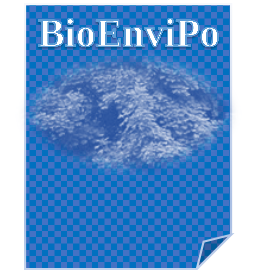Morphological character analysis of Rasbora borneensis
DOI:
https://doi.org/10.31763/bioenvipo.v3i2.675Keywords:
Rasbora Borneensis, Morphology, Morphometric, West KalimantanAbstract
Rasbora borneensis is a local fish of West Kalimantan that has the potential to be developed as farmed fish and biomedical research model animals. The utilization of fish potential as aquaculture animals and biomedical research model animals requires data on the biological aspects of these fish. Data from Fish Base (2023) shows that until now the biological information of Rasbora borneensis is still very limited, both morphological, anatomical, and reproductive data. This study aims to analyze the morphological characters of Rasbora borneensis. The results of this study show that there are morphological differences between male and female Rasbora borneensis fish. Female fish show a rounded flat body shape, while male fish show a flat body shape. The measurement results show that the morphometric ratio of male and female fish is different. However, when viewed based on variations in the size of the specimens used, there are several sizes that have the same value.
References
Kottelat, M., Whitten, A. J., Kartikasari, N. & Wirjoatmodjo, S. Freshwater fishes of Western Indonesia and Sulawesi. Copeia (1994). https://doi.org/10.2307/1447208
Rosadi, E. Hasil tangkapan ikan Seluang Batang (Rasbora Argyrotaenia Blkr 1850) berdasarkan umur bulan (Moon Age) di Sungai Barito Kalimantan Selatan. Fish Sci. 4, 12 (2014).
Suryadi, K. S., Junardi, J., & Setyawati, T. R. Keanekaragaman jenis ikan di hilir Sungai Sekadau Kalimantan Barat. J. Protobiont 8, 82–87 (2019). https://doi.org/10.26418/protobiont.v8i2.34035
Kottelat, M. & Widjanarti, E. The fishes of Danau Sentarum National Park and the Kapuas Lakes Area, Kalimantan Barat, Indonesia. Raffles Bull. Zool. 13, 139–173 (2005).
Budiharjo, A. Selection and potential aquaculture of “wader†fish of the Genus Rasbora. Biodiversitas J. Biol. Divers. 3, 225–230 (2002). https://doi.org/10.13057/biodiv/d030203
D’Angelo, L., Lossi, L., Merighi, A. & de Girolamo, P. Anatomical features for the adequate choice of experimental animal models in biomedicine: I. Fishes. Ann. Anat. 205, 75–84 (2016). https://doi.org/10.1016/j.aanat.2016.02.001
Pratama, S. F., Retnoaji, B. & Ana, I. D. Effects of Carbonate Hydroxyapatite (CHA) on the development of heart and cranium cartilage of Zebrafish (Danio rerio Hamilton, 1882) Larvae. Chiang Mai Univ. J. Nat. Sci. 21, 1–16 (2022). https://doi.org/10.12982/CMUJNS.2022.041
Pratama, S. F., Ana, I. D. & Retnoaji, B. The effect of Carbonate Hydroxyapatite (CHA) dental implant material on the early development of Zebrafish embryos (Danio rerio) . Proc. 3rd KOBI Congr. Int. Natl. Conf. (KOBICINC 2020) 14, 307–312 (2021). https://doi.org/10.2991/absr.k.210621.052
Retnoaji, B. et al. Embryonic development of Indonesian native fish yellow rasbora (Rasbora lateristriata). J. King Saud Univ. - Sci. 35, 102810 (2023). https://doi.org/10.1016/j.jksus.2023.102810
Zahro, H., Anshori, K., Fransisco, S., Rosa, A. A. & Retnoaji, B. Reproductive aspect and embryonic development of Wader pari Fish ( Rasbora lateristriata Bleeker 1854) from Malang East Java . Proc. 7th Int. Conf. Biol. Sci. (ICBS 2021) 22, 540–544 (2022). https://doi.org/10.2991/absr.k.220406.076
Dwivedi, A. K. & Dubey, V. K. Advancements in morphometric differentiation: A review on stock identification among fish populations. Rev. Fish Biol. Fish. 23, 23–39 (2013). https://doi.org/10.1007/s11160-012-9279-1
Eagderi, S., Poorbagher, H., Moshayedi, F. & Hosseini, S. Original article morphological development and allometric growth patterns of Acipenser persicus Borodin, 1897 (Actinopterygii, Acipenseridae) during early development. 5, (2017).
Baur, H. & Leuenberger, C. Analysis of ratios in multivariate morphometry. Syst. Biol. 60, 813–825 (2011). https://doi.org/10.1093/sysbio/syr061
Fish Base. Rasbora borneensis Bleeker, 1860. https://fishbase.net.br/summary/Rasbora-kalbarensis.html (2023).
Retnoaji, B. et al. Tata Cara Pemijahan Ikan Wader Pari (Rasbora lateristriata). (UGM Press, 2023).
Dorado, E. L., Torres, M. A. J. & Demayo, C. G. Sexual dimorphism in body shapes of the spotted barb fish, Puntius binotatus of Lake Buluan in Mindanao, Philippines. AACL Bioflux 5, 321–329 (2012).
Strauss, R. & Bookstein, F. The truss : Body form reconstructions in morphometrics. Systematic Biology 31, 113–135 (1982). https://doi.org/10.1093/sysbio/31.2.113
Nacua, S., Dorado, E. L., Torres, M. A. & Demayo, C. Body shape variation between two populations of the white goby, Glossogobius giuris (Hamilton and Buchanan). Res J Fish Hydrobiol 5, 44–51 (2010).
Muchlisin, Z. A. Potensi ikan air tawar di aceh sebagai dasar untuk pengembangan budi daya. J. Ikhtiologi Indones. 13, 91–96 (2013).
Herler, J., Kerschbaumer, M., Mitteroecker, P., Postl, L. & Sturmbauer, C. Sexual dimorphism and population divergence in the Lake Tanganyika cichlid fish genus Tropheus. Front. Zool. 7, 1–10 (2010). https://doi.org/10.1186/1742-9994-7-4
Downloads
Published
How to Cite
Issue
Section
License
Copyright (c) 2023 Sandi Fransisco Pratama, Khairillah Yuyun Nisaul, Pasmawati Pasmawati, Fitriagustiani Fitriagustiani

This work is licensed under a Creative Commons Attribution-ShareAlike 4.0 International License.
Authors who publish with BIOLOGICAL ENVIRONMENT AND POLLUTION agree to the following terms:
- Authors retain copyright and grant the journal right of first publication with the work simultaneously licensed under a Creative Commons Attribution License (CC BY-SA 4.0) that allows others to share the work with an acknowledgment of the work's authorship and initial publication in this journal.Â
- Authors are able to enter into separate, additional contractual arrangements for the non-exclusive distribution of the journal's published version of the work (e.g., post it to an institutional repository or publish it in a book), with an acknowledgment of its initial publication in this journal.
- Authors are permitted and encouraged to post their work online (e.g., in institutional repositories or on their website) prior to and during the submission process, as it can lead to productive exchanges, as well as earlier and greater citation of published work.


